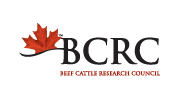Effects of feeding ethanol byproducts on manure nutrient levels
| Project Code: | 7.19 |
| Completed: | June 2011 |
Project Title:
Evaluation of Distillers’ Grains from Ethanol Plants for Feedlot Cattle
Researchers:
Wenzhu Yang yangw@agr.gc.ca
Tim McAllister, Karen Beauchemin, Darryl Gibb (AAFC Lethbridge) and John McKinnon (University of Saskatchewan)
Background
When bio-ethanol is produced from corn, wheat or other grains, yeast converts the grain starch into glucose, and ferments the glucose into ethanol. The non-starch components of the grain are not converted to ethanol, and end up in dried distillers’ grains with solubles (DDGS) and other by-products. Fiber, protein, fat and mineral levels are about three times more concentrated in DDGS than in the original grain.
Although cattle can use the fiber, protein and fat from DDGS for energy, the increased protein and mineral levels in DDGS may be problematic. When cattle consume more protein than they need, the excess protein can be metabolized for energy. Protein metabolism also releases nitrogen (N), which is converted to urea in the kidneys and excreted, primarily in the urine. Similarly, if cattle consume more phosphorus (P) than they can absorb, much of the excess P will be excreted in the manure. Provincial nutrient management regulations are increasingly focused on levels of N, P, or both.
Objective
To determine how incorporating DDGS into beef cattle finishing diets impacts manure nutrient levels.
What they did
In two studies, finishing diets containing varying levels of DDGS were fed to heifers weighing 925 to 1000lbs. Each animal (or pair of animals) was fed a specific diet for a three week period. After two weeks of adaptation to the diets, nutrient digestibility was evaluated from a series of intensive feed intake, rumen, urine and fecal measurements. The animals were then rotated to a different diet and studied after two weeks of adaptation. This process repeated until all animals had been fed all of the diets.
In the first study, researchers at the University of Saskatchewan compared a control diet (89% rolled barley, 6% barley silage, 5% supplement) to four diets that replaced some of the barley grain with 20 or 40% corn DDGS, or 20 or 40% wheat DDGS.
In the second study, researchers at the Lethbridge Research Station compared a control diet (83% temper-rolled barley, 15% barley silage, 2% supplement) to three diets that replaced 20% of the barley and 5%, 10% or 15% of the silage with 25%, 30% or 35% wheat DDGS.
What they learned
When grain was replaced with DDGS, dietary crude protein and P levels rose as the amount of DDGS in the diet increased. Feed intake did not change a great deal, so this meant that the animals consumed more N and P as more grain was replaced with DDGS. Manure and/or urine production also tended to increase as the DDGS content of the diet increased. Greater amounts of N and P were excreted as DDGS inclusion rates rose. The manure had higher N and P values when cattle were fed wheat DDGS than when they were fed corn DDGS.
When silage was replaced with DDGS, dietary crude protein and P levels also rose as the amount of DDGS in the diet increased. Feed intakes continually dropped as more silage was replaced with DDGS. Therefore, the increase in dietary N and P concentration that occurred as silage was replaced with DDGS was balanced out by the drop in feed intake. As a result, cattle ate about the same amount of N and P, and excretion rates for both nutrients were fairly stable as dietary DDGS level increased from 20 to 30 to 35% DDGS. If manure output decreased due to reduced feed intake, the concentration of N and P in the manure may have increased.
What it means
Incorporating DDGS into feedlot finishing diets can increase the amount of N and P excreted by beef cattle and could increase the land base needed for spreading. As DDGS replaces increasing amounts of grain in the diet, manure N and P levels rise steadily. When DDGS replaces silage in the diet, manure N and P concentrations increase, but this may be partly offset by lower manure production. Under commercial conditions, the N and P concentrations in feedlot manure will also be influenced by bedding, weather conditions and other factors that affect nutrient runoff and ammonia volatilization.








